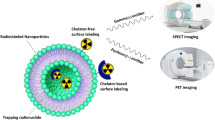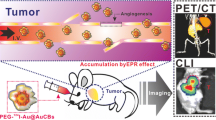Abstract
The health effects of ambient PM 2.5 and its potential mechanisms have generated considerable interest. In vitro cell studies and ex vivo animal experiments may not accurately determine the characteristics of PM 2.5 particles. To better understand their detailed mechanisms, we performed an in vivo study using single photon emission tomography (SPECT) imaging. To mimic the PM 2.5 particles, SiO2 nanoparticles modified by ethylene carbonate or polyvinyl pyrrolidone were labeled with 131I. After administration via inhalation, in vivo SPECT imaging of the radiolabeled particles in sprague dawley rats was performed. It was found that radioactivity accumulated in the lungs and trachea 6 and 24 h after administration. In addition, significant radioactivity was observed in the abdomen, including the liver and kidneys. The results were also confirmed by ex vivo autoradiography. This study revealed that in vivo SPECT imaging could be an effective method for investigating the properties of PM 2.5 particles.




Similar content being viewed by others
References
G.H. Yang, Y. Wang, Y.X. Zeng et al., Rapid health transition in China, 1990–2010: findings from the global burden of disease study 2010. Lancet (London, England) 381(9882), 1987–2015 (2013). https://doi.org/10.1016/S0140-6736(13)61097-1
J. Lelieveld, J.S. Evans, M. Fanis et al., The contribution of outdoor air pollution sources to premature mortality on a global scale. Nat. 525(7569), 367–371 (2015). https://doi.org/10.1038/nature15371
H.B. Guo, S.J. Huang, M.X. Chen et al., Air pollutants and asthma patient visits: Indication of source influence. Sci. Total Environ. 625, 355–362 (2018). https://doi.org/10.1016/j.scitotenv.2017.12.298
V.C. Pan, F. Kazemiparkouhi, J. Manjourides et al., Long-term PM 2.5 exposures and respiratory, cancer and cardiovascular mortality in american older adults. Am. J. Epidemiol. 186(8), 961–969 (2017)
Q. Wang, J.N. Wang, M.Z. Zeng et al., A county-level estimate of PM 2.5 related chronic mortality risk in China based on multi-model exposure data. Environ. Int. 110, 105–112 (2017)
E.H. Wilker, S.R. Preis, A.S. Beiser et al., Long-term exposure to fine particulate matter, residential proximity to major roads and measures of brain structure. Stroke 46(5), 1161–1166 (2012). https://doi.org/10.1161/STROKEAHA.114.00834
A. Zanobetti, J. Schwartz, The effect of fine and coarse particulate air pollution on mortality: a national analysis. Environ. Health Perspect. 117(6), 898–903 (2009). https://doi.org/10.1289/ehp.0800108
M. Franklin, P. Koutrakis, J. Schwartz, The role of particle composition on the association between PM 2.5 and mortality. Epidemiol. 19(5), 680–689 (2002)
K.A. Miller, D.S. Siscovick, L. Sheppard et al., Long-term exposure to air pollution and incidence of cardiovascular events in women. New Engl. J. Med. 356(5), 447–458 (2007). https://doi.org/10.1016/j.envint.2017.10.015
J. Lelieveld, J.S. Evans, M. Fnais et al., The contribution of outdoor air pollution sources to premature mortality on a global scale. Nat. 525(7569), 367–371 (2015). https://doi.org/10.1056/NEJMoa054409
W. Liu, M. Zhang, J. Feng et al., The influence of quercetin on maternal immunity, oxidative stress, and inflammation in mice with exposure of fine particulate matter during gestation. Int. J. Environ. Res. Public Health 14(6), 592–607 (2017). https://doi.org/10.3390/ijerph14060592
O.G. Aztatzi-Aguilar, M. Uribe-Ramírez, J. Narváez-Zorales et al., Early kidney damage induced by subchronic exposure to PM 2.5 in rats. Part. Fibre Toxicol. 13(1), 68–87 (2016)
Y. Wei, X.N. Cao, X.L. Tang et al., Urban fine particulate matter (PM 2.5) exposure destroys blood-testis barrier (BTB) integrity through excessive ROS-mediated autophagy. Toxicol. Mech. Methods 28(4), 302–339 (2018)
W. Zhou, D.D. Tian, H. Jun et al., Repeated PM 2.5 exposure inhibits BEAS-2B cell P53 expression through ROS-Akt-DNMT3B pathway-mediated promoter hypermethylation. Oncotarget 7(15), 20691–20703 (2016)
B. Crobeddu, L. Aragao-Santiago, L.C. Bui et al., Oxidative potential of particulate matter 2.5 as predictive indicator of cellular stress. Environ. Pollut. 230, 125–135 (2017)
S.L. Feng, D. Gao, F. Liao et al., The health effects of ambient PM 2.5 and potential mechanisms. Ecotoxicol. Environ. Saf. 128, 67–74 (2016)
M. Plusquin, F. Guida, S. Polidoro et al., DNA methylation and exposure to ambient air pollution in two prospective cohorts. Environ. Int. 108, 127–136 (2017). https://doi.org/10.1016/j.envint.2017.08.006
R.J. Chen, X. Meng, A. Zhao et al., DNA hypomethylation and its mediation in the effects of fine particulate air pollution on cardiovascular biomarkers: a randomized crossover trial. Environ. Int. 94, 614–619 (2016). https://doi.org/10.1016/j.envint.2016.06.026
B. Leclercq, A. Platel, S. Antherieu et al., Genetic and epigenetic alterations in normal and sensitive COPD diseased human bronchial epithelial cells repeatedly exposed to air pollution derived PM 2.5. Environ. Pollut. 230, 163–177 (2017)
C.V. Breton, J. Yao, J. Millstein et al., Prenatal air pollution exposures, DNA methyl transferase genotypes, and associations with newborn LINE1 and alu methylation and childhood blood pressure and carotid intima-media thickness in the Children’s Health Study. Environ. Health Perspect. 124(12), 1905–1912 (2016). https://doi.org/10.1289/EHP181
B.F. Cachon, S. Firmin, A. Verdin et al., Proinflammatory effects and oxidative stress within human bronchial epithelial cells exposed to atmospheric particulate matter (PM 2.5 and PM >2.5) collected from Cotonou, Benin. Environ. Pollut. 185, 340–351 (2014)
C.W. Liu, T.L. Lee, Y.C. Chen et al., PM 25 induced oxidative stress increases intercellular adhesion molecule-1 expression in lung epithelial cells through the IL-6/AKT/STAT3/NF-kappaB-dependent pathway. Part Fibre Toxicol. 15(1), 4–19 (2018)
T. Ku, B. Li, R. Gao et al., NF-kappaB-regulated microRNA-574-5p underlies synaptic and cognitive impairment in response to atmospheric PM 2.5 aspiration. Part Fibre Toxicol. 14(1), 34–52 (2017)
B. Carney, S. Kossatz, T. Reiner, Molecular imaging of PARP. J. Nucl. Med. 58(7), 1025–1030 (2017). https://doi.org/10.2967/jnumed.117.189936
K.H. Jung, K.H. Lee, Molecular imaging in the era of personalized medicine. J. Pathol. Transl. Med. 49(1), 43–58 (2013). https://doi.org/10.4132/jptm.2014.10.24
B.S. Jang, MicroSPECT and MicroPET imaging of small animals for drug development. Toxicol. Res. 29(1), 1–6 (2013). https://doi.org/10.5487/TR.2013.29.1.001
D.R. Osborne, C. Kuntner, S. Berr et al., Guidance for efficient small animal imaging quality control. Mol. Imaging Biol. 19(4), 485–498 (2017). https://doi.org/10.1007/s11307-016-1012-3
M. D’Huyvetter, J. De Vos, C. Xavier et al., 131I-labeled Anti-HER2 camelid sdAb as a theranostic tool in cancer treatment. Clin. Cancer Res. An Official J. Am. Assoc. Cancer Res. 23(21), 6616–6628 (2017). https://doi.org/10.1158/1078-0432.CCR-17-0310
J. Sheng, X.Y. Wang, J. Yan et al., Theranostic radioiodine-labelled melanin nanoparticles inspired by clinical brachytherapy seeds. J. Mater. Chem. B 6(48), 8163–8169 (2018). https://doi.org/10.1039/c8tb02817f
G.Y. Song, Z.J. Li, K.H. Li et al., SiO2/ZnO composite hollow sub-micron fibers: fabrication from facile single capillary electrospinning and their photoluminescence properties. Nanomater. 7(3), 53–62 (2017). https://doi.org/10.3390/nano7030053
C.S. Thompson, M. Zou, Nanostructured PVP/SiO2 antireflective coating for solar panel applications. Nanotechnol. IEEE (2013). https://doi.org/10.1109/NANO.2013.6721058
G. Hatch, R. Slade, E. Boykin et al., Correlation of effects of inhaled versus intratracheally injected metals on susceptibility to respiratory infection in mice. Am. Rev. Respir. Dis. 124, 167–173 (1981). https://doi.org/10.1164/arrd.1981.124.2.167
Y.K. Dewaraja, M. Ljungberg, A.J. Green et al., MIRD pamphlet No. 24: guidelines for quantitative 131I SPECT in dosimetry applications. J. Nucl. Med. 54(12), 2182–2188 (2013)
J.G. Miller, J.S. Gillette, E.M. Manczak et al., Fine particle air pollution and physiological reactivity to social stress in adolescence: the moderating role of anxiety and depression. Psychosom. Med. 81(7), 641–648 (2019). https://doi.org/10.1097/PSY.0000000000000714
P.L. Ljungman, M.A. Mittleman, Ambient Air Pollution and Stroke. Stroke 45(12), 3734–3741 (2014). https://doi.org/10.1161/STROKEAHA.114.003130
Author information
Authors and Affiliations
Corresponding authors
Additional information
This work was supported by the National Natural Science Foundation of China (Nos. 31671035, 51803082), National Significant New Drugs Creation Program (No. 2017ZX09304021), Jiangsu Province Foundation (Nos. BK20170204, BK20161137), and Jiangsu Provincial Medical Innovation Team (Nos. CXTDA2017024, LGY2017088, QNRC2016628).
Rights and permissions
About this article
Cite this article
Pan, DH., Sheng, J., Wang, XY. et al. In vivo SPECT imaging of an 131I-labeled PM 2.5 mimic substitute. NUCL SCI TECH 31, 111 (2020). https://doi.org/10.1007/s41365-020-00818-2
Received:
Revised:
Accepted:
Published:
DOI: https://doi.org/10.1007/s41365-020-00818-2




